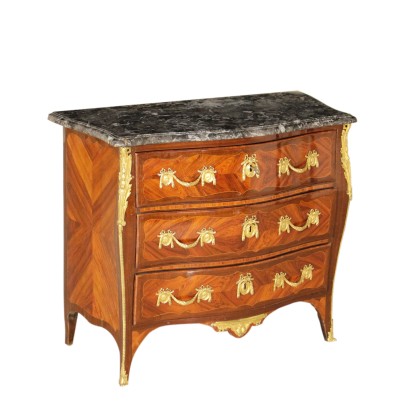Chest of Drawers Transition France Last Quarter of 1700s
Features
Style: Transition (1760-1790)
Age: 18th Century / 1701 - 1800
Origin: France
Main essence: Maple , Brazilian Rosewood , Tulipwood , Mahogany
Material: Gilded Bronze
Description
An elegant chest of drawers, Transition style. Serpentine front and sides and three drawers. Slabbed marble top. Bois de violette quadripartite reserves threaded with maple. Embellished with friezes and gilded bronze handles. Manufactured in France, last quarter of the 18th century.
Product Condition:
Good condition. Wear consistent with age and use. Any damage or loss is displayed as completely as possible in the pictures.
Dimensions (cm):
Height: 83,5
Width: 100,5
Depth: 50
Additional Information
Style: Transition (1760-1790)
Sotto l'influenza della nuova sensibilità neo-classica, i cassettoni e le credenze del Settecento Francese lasciano il carattere di fantasia e di immaginazione che avevano sotto Luigi XV per prendere forme più semplice e lineare tipiche dell'epoca Luigi XVI (che regnò dal 1774 al 1793)
Age: 18th Century / 1701 - 1800
18th Century / 1701 - 1800 Main essence:
Maple
Hard, light wood used for inlays. It grows mainly in Austria, but it is widespread throughout the northern hemisphere, from Japan to North America, passing through China and Europe. It is one of the lightest woods ever, tending to white, it is similar to lime or birch wood. The briar is used in the production of ancient secretaires .
Brazilian Rosewood
It is a hard, light blond wood, but with strong red and pinkish veins, which is obtained from tropical trees similar to rosewood. Its veins are reminiscent of striped tulips, which is why it is called tulipwood in English-speaking areas. It is used for inlays, often combined with bois de violette. In the 1700s and 1800s it was highly appreciated and used in France and England for precious veneers. It gives off scent for decades if not centuries after curing.
Tulipwood
Obtained from some types of acacia, it is a hard essence, with purplish-colored veins, used in the inlays, in which, alongside the bois de rose, it generates beautiful contrasts. Also useful for making bronze accessories stand out.
Mahogany
It is one of the most precious and sought-after woods in cabinet making. It was discovered in Central America around 1600 and began to be imported to England in the 1700s. Much appreciated for its hardness and indestructibility, it became widespread following the blocking of walnut exports from France in 1720 and the consequent elimination of English import duties on mahogany from the colonies in America and India. The most valuable version comes from Cuba, but it became very expensive. At the end of the 18th century it began to be used also in France in Louis XVI, Directory and Empire furniture, its diffusion declined starting from when Napoleon, in 1810, forbade its import. It was generally used in the manufacture of elegant furniture, due to its characteristics and beautiful grain.
Material: Gilded Bronze




























